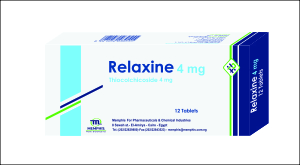1.NAME OF THE MEDICINAL PRODUCT: RELAXINE TABLET 2.QUALITATIVE AND QUANTITATIVE COMPOSITION Each tablet contains: Active ingredient: Thiocolchicoside 4 mg Significant excipient(s): Lactose monohydrate. For a full list of excipients, see section 6.1. COMPOSITION: Excipients: Talc, sucrose, Starch potato, Lactose monohydrate, Gelatin powder, Magnesium stearate. 3.PHARMACEUTICAL FORM: Yellow, round, biconvex tablet. 4. CLINICAL DATA 4.1 THERAPEUTIC INDICATIONS Adjunctive treatment of painful muscular contractures in acute spinal pathology in adults and adolescents from 16 years of age. 4.2. DOSAGE AND METHOD OF ADMINISTRATION Dosage RELAXINE is not recommended for longer-term treatment of chronic conditions. The recommended maximum dose is 8 mg every 12 hours (16 mg per day). The duration of treatment is limited to 7 consecutive days. Doses higher than those recommended or long-term use should be avoided (see section 4.4). When given Thiocolchicoside intramuscularly, the maximum dose should be 4 mg every 12 hours, for up to 5 days. Pediatric population RELAXINE should not be used in children and adolescents under 16 years of age for safety reasons. Method of administration: Oral administration. Swallow the tablets with a glass of water. 4.3. CONTRAINDICATIONS • Hypersensitivity to the active substance or to any of the excipients mentioned in section 6.1 or to colchicine. • Pregnancy and lactation. • In women of childbearing potential who are not using effective contraception during treatment with THIOCOLCHICOSIDE and for 1 month after stopping treatment. • Men who are not willing to use effective contraceptive measures during treatment with THIOCOLCHICOSIDE and for 3 months after stopping treatment. 4.4 SPECIAL WARNINGS AND PRECAUTIONS FOR USE Special warnings In patients with epilepsy or at risk of seizures, THIOCOLCHICOSIDE may induce seizures. It is, therefore, recommended that the benefit-risk ratio of THIOCOLCHICOSIDE be evaluated and that clinical monitoring be reinforced. Upon the occurrence of seizure, treatment should be discontinued. Cases of hepatic injury (e.g., cytolytic or cholestatic hepatitis) have been reported with THIOCOLCHICOSIDE since its marketing. Severe cases (fulminant hepatitis) have been reported in patients taking concomitant NSAIDs or paracetamol. Patients should discontinue treatment and contact their physician if signs and symptoms of liver damage develop (see section 4.8). Precautions for use In case of diarrhea, reduce the dosage. If necessary, ingest the tablets with an Antacid agent.
